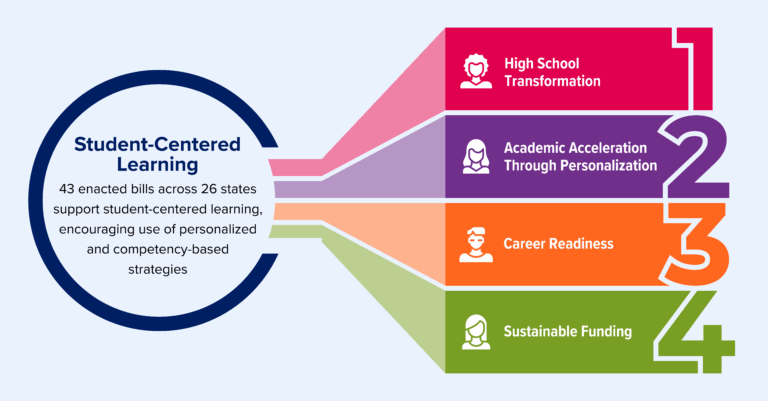Our nation’s high schools are not adequately preparing students for future success. While high school graduation rates are at historically high levels, college remediation rates suggest too many students are not ready for what comes next. Many students are disengaged from school, and teachers, parents and voters all want to see our education systems evolve to address today’s challenges.

States across the country are turning to high school transformation as one strategy to address this challenge. High school transformation, also referred to as high school redesign, aims to make sure that students graduate well-prepared for success. States taking on this challenge must consider how the policy environment that they create will impact the ability of districts, schools and teachers to create innovative student-centered experiences.
While there are many state policies that impact high school transformation efforts, one of the most effective ways that we at KnowledgeWorks believe states can advance high school transformation is by grounding graduation requirements in competency-based practices. Graduation requirements articulate the range of knowledge and durable skills that learning communities have collectively decided students should know by the time that they leave high school, while a competency-based approach to education centers each students’ strengths, needs and interests and ensures that they can show mastery in ways – and at a time and place – that makes sense to them. When combined, the principles inherent in competency-based education can allow students to pursue a personalized graduation path that leverages their unique talents and interests.
We recently undertook a deep dive into several states that have elements of personalization and competency-based education embedded in their graduation requirements to identify trends and possible best practices. Here are four key areas that we saw consistently that states seeking to transform their graduation requirements should consider.
Expanding what students need to know and be able to do to graduate
While traditional graduation requirements are primarily grounded in content-defined course or testing requirements, competency-based education goes further. Alongside rigorous academic content, competency-based education asks students to demonstrate mastery of durable skills crucial to postsecondary and workforce readiness.
- Virginia, for example, requires that all students demonstrate the foundational skills of its Profile of a Graduate before graduating.
- Texas requires that all students demonstrate proficiency in higher order skills like communication, listening and critical thinking.
- Starting with the graduating class of 2028, Rhode Island will require that students complete a performance-based diploma option that shows their mastery of applied learning skills.
- States like North Dakota and Indiana have already introduced or are developing graduation pathways that push students beyond traditional academic coursework and require them to demonstrate their readiness in postsecondary education and workforce opportunities through a menu of experiences.
Grounding advancement in mastery, not seat time
Competency-based education allows students to move at a pace that makes sense for them while making sure they have the support they need to be successful. This moves credit accumulation away from the tradition of the time-based Carnegie Unit and centers it instead on what students know. Almost all the states that we reviewed give schools and/or districts wide-ranging latitude to award credits based on mastery, with some notably going further than others. For example:
- Rhode Island recently redefined “credit” primarily through demonstration of competencies by means not bound by seat time or instructional minute requirements.
- Other states like Minnesota and Washington take a hybrid approach, allowing districts to continue awarding credit using seat time as a basis, but creating a clear and statutorily protected flexibility for grounding credit in mastery.
- At least one state, Arizona, has developed a mastery-based diploma option that allows students to move at their own pace toward achieving graduation requirements.
Rethinking where, when and how graduation requirements can be met
Competency-based education moves beyond the time and location constraints imposed by the Carnegie Unit and asks students to demonstrate mastery, regardless of the time, place or method that they may use for doing so. Many states have introduced policy flexibilities that codify this level of student choice.
- Kentucky, for example, places more specific requirements on the first two years of high school but allows students to then select a much broader range of courses to meet their graduation requirements in their final two years.
- New Jersey‘s statute allows students to meet the state’s graduation requirements through a range of experiences that enable students to pursue a variety of individualized learning opportunities.
- Rhode Island allows students to meet multiple content area requirements by integrating them into a single course, which are referred to as flex credits.
- New Mexico students can meet the state’s required demonstration of competencies in core academic domains through activities such as capstones and performance tasks rather than traditional testing.
Balancing local control with reasonable state guardrails
Competency-based education moves beyond a one-size-fits-all model and seeks to personalize education for all students. While nearly every state dictates some level of baseline graduation requirements, many of the states that we reviewed balance this with considerable local flexibility in determining what students know and how they’ll demonstrate it in relation to graduation requirements.
- Colorado gives local districts a wide variety of methods by which students can demonstrate mastery of content-level standards and encourages districts to benchmark programs of study to postsecondary admissions standards.
- New Jersey directs boards to approve a broad range of individual student learning opportunities.
- Rhode Island gives local districts the flexibility to determine when students have met requirements.
- Washington delegates authority to districts to write policy for the awarding credit for students who demonstrate mastery within some mandated requirements.
Grounding graduation requirements in competency-based practices represents one key way that states can enable innovative local high school transformation. Making sure that graduation requirements are thought of more expansively, independent of seat time, and giving increased flexibility for local districts to determine when, where and how they can be met can create the space for schools and districts to transform the high school experience.








